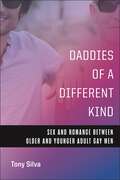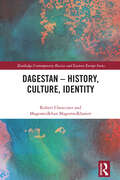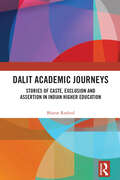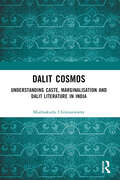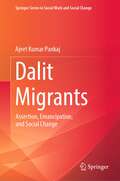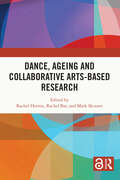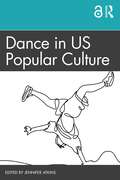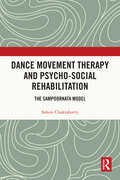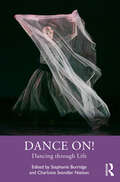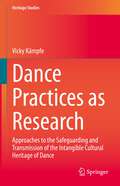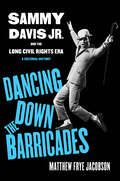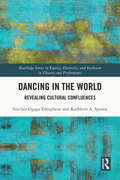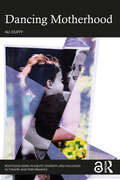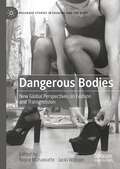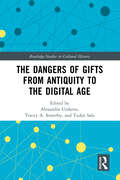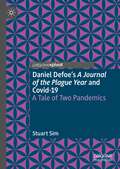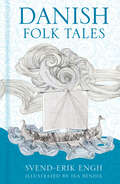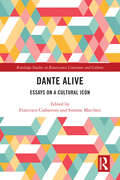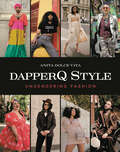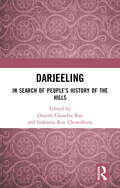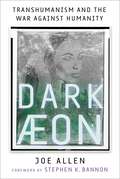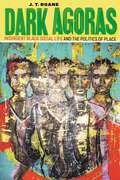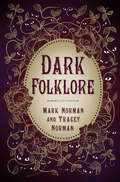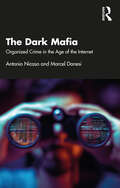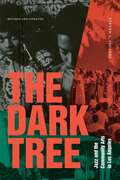- Table View
- List View
Daddies of a Different Kind: Sex and Romance Between Older and Younger Adult Gay Men
by Tony SilvaAn intimate look at gay and bisexual daddies and their younger partnersOver the past several years the term “daddy” has increased in popularity. Although the term has existed for centuries, its meaning has changed over time, and today can refer to desirable older men. In the Western world, same-sex male couples are far more likely to have large age gaps than other types of partnerships, and Daddies of a Different Kind analyzes the stories of gay and bisexual daddies and asks why younger men are interested in older men for sex and relationships.Based on interviews with self-described daddies and young adult men in relationships with older men, Tony Silva uncovers why it is more common for gay and bisexual men to have large age gaps in relationships than heterosexuals or LGBTQ women. These stories reveal that queer relationships with large age gaps are not consistent with a sugar daddy/gold digger stereotype. Instead, daddies mentor younger adult men and transmit knowledge intergenerationally, including how to navigate homophobia, access gay communities, and have fulfilling sex. Silva shows that demographic research understates the commonality of age-gap pairings among gay and bisexual men, and illustrates how daddies shape gay and bisexual communities both culturally and sexually. A fascinating read, Daddies of a Different Kind breaks many commonly held stereotypes about gay and bisexual life.
Dagestan - History, Culture, Identity (Routledge Contemporary Russia and Eastern Europe Series)
by Robert Chenciner Magomedkhan MagomedkhanovDagestan – History, Culture, Identity provides an up-to-date and comprehensive overview of Dagestan, a strategically important republic of the Russian Federation which borders Chechnya, Georgia and Azerbaijan, and its people. It outlines Dagestan’s rich and complicated history, from 5th c ACE to post USSR, as seen from the viewpoint of the Dagestani people. Chapters feature the new age of social media, urban weddings, modern and traditional medicine, innovative food cultivation, the little-known history of Mountain Jews during the Soviet period, flourishing heroes of sport and finance, emerging opportunities in ethno-tourism and a recent Dagestani music revival. In doing so, the authors examine the large number of different ethnic groups in Dagestan, their languages and traditions, and assess how the people of Dagestan are coping and thriving despite the changes brought about by globalisation, new technology and the modern world: through which swirls an increasing sense of identity in an indigenous multi-ethnic society.
Dalit Academic Journeys: Stories of Caste, Exclusion and Assertion in Indian Higher Education
by Bharat RathodThis book provides a comprehensive overview of the academic journeys of Dalit students and their lived experiences of systemic exclusion in Indian higher education. It explains their educational journeys beyond caste-based discrimination, specifically analyzing the power dynamics, resilience, and resistance in their institutional life. The volume, — Describes institutional culture, practices and contexts that contribute to a negative environment for Dalit students, and what changes would be required to create a positive campus climate for them; — Provides a comparative analysis with the United States higher education contexts while drawing theoretical frameworks from critical race theory in educational settings, social reproduction theory and diversity research; — Discusses the significance of developing anti-casteist, democratic and inclusive university spaces in India, with an emphasis on how Indian university campuses can be transformed through diversity, equity, inclusion initiatives and indispensable support programs to assist Dalit and other vulnerable students; Nuanced and accessible, this book will be of interest to students, teachers and researchers of education, higher education, sociology, exclusion studies, and Dalit studies. It will also be useful for policymakers, social activists, NGOs, research centres and those working in the areas of higher education, reservations, public policy, caste, anti-caste and exclusion studies.
Dalit Cosmos: Understanding Caste, Marginalisation and Dalit Literature in India
by Mudnakudu ChinnaswamyThis book is a fierce argument against social and caste discrimination in India, especially untouchability and emphatic call for social justice. Written by a first-generation Kannada Dalit writer, the book provides an insider’s view of caste discrimination as the author has lived through and experienced it. It traces the roots of present-day activism against caste discrimination, the influence of Ambedkar, the rise of Hindutva, and the role of Dalit literatures in shaping discourses around caste in India. An invigorating collection of essays and speeches by Mudnakudu Chinnaswamy, this volume will be of great interest to scholars and researchers of discrimination, literature, politics and political philosophy, exclusion studies, race, social justice, cultural studies, and South Asian studies.
Dalit Migrants: Assertion, Emancipation, and Social Change (Springer Series in Social Work and Social Change)
by Ajeet Kumar PankajThis book offers a detailed narrative of Dalit migrants' everyday experience in urban areas with regard to the availability and accessibility of welfare services and state institutions. It discusses caste, specifically the identity of integration for Dalit migrants and the social work profession to integrate a marginalized community. Further, the book also highlights social, political, cultural, and economic changes among Dalit migrants in cities.The book traces the trajectory of Dalit migrants and captures their mobility from rural to urban areas, which is a complex economic and social phenomenon. In consideration of this complexity, the author explores the process of migration in its finer details through a focus on lived experiences of Dalit migrants in cities. Dalits often migrate to cities in search of better employment and livelihood opportunities because their occupations are invariably associated with their caste in villages. This book investigates the role of caste-based identity in Dalit migrants’ emancipation and integration in cities. In addition, the book examines the role of caste in the exclusion of Dalit migrants in cities and explains the dynamic nature of the 'state' and Dalit migrants' assertion.Among the topics covered in the book's seven chapters:Mumbai/Bombay: Migration, Caste, and DalitsCaste and Migration: The City—A Site for ‘Inclusion’ and EmancipationEntitlement, Deprivation, and Basic Services: Everyday Experience of Dalit Migrants with the StateDalit Migrants: Assertion, Emancipation, and Social Change is intended for students, academicians, and researchers in social work, migration studies, labour studies, development studies, population science, and economics. Developmental professionals also will be keen to read the book.
Dance, Ageing and Collaborative Arts-Based Research
by Rachel Herron Rachel Bar Mark SkinnerDance, Ageing and Collaborative Arts-Based Research contributes a critical and comprehensive perspective on the role of the arts –specifically dance – in enhancing the lives of older people. The book focuses on the development of an innovative arts-based program for older adults and the collaborative process of exploring and understanding its impact in relation to ageing, social inclusion, and care. It offers a wide audience of readers a richer understanding of the role of the arts in ageing and life enrichment, critical contributions to theories of ageing and care, specific approaches to arts-based collaborative research, and an exploration of the impact of Sharing Dance from the perspective of older adults, artists, researchers, and community leaders. Given the interdisciplinary and collaborative nature of this book, it will be of interest across health, social science, and humanities disciplines, including gerontology, sociology, psychology, geography, nursing, social work, and performing arts. Licence line: Creative Commons Attribution-Non Commercial-No Derivatives 4.0 license.
Dance in US Popular Culture
by Jennifer AtkinsThis innovative textbook applies basic dance history and theory to contemporary popular culture examples in order to examine our own ways of moving in—and through—culture. By drawing on material relevant to students, Dance in US Popular Culture successfully introduces students to critical thinking around the most personal of terrain: our bodies and our identities. The book asks readers to think about: what embodied knowledge we carry with us and how we can understand history and society through that lens what stereotypes and accompanying expectations are embedded in performance, related to gender and/or race, for instance how such expectations are reinforced, negotiated, challenged, embraced, or rescripted by performers and audiences how readers articulate their own sense of complex identity within the constantly shifting landscape of popular culture, how this shapes an active sense of their everyday lives, and how this can act as a springboard towards dismantling systems of oppression Through readings, questions, movement analyses, and assignment prompts that take students from computer to nightclub and beyond, Dance in US Popular Culture readers develop their own cultural sense of dance and the moving body’s sociopolitical importance while also determining how dance is fundamentally applicable to their own identity. This is the ideal textbook for high school and undergraduate students of dance and dance studies in BA and BfA courses, as well as those studying popular culture from interdisciplinary perspectives including cultural studies, media studies, communication studies, theater and performance studies.
Dance Movement Therapy and Psycho-social Rehabilitation: The Sampoornata Model
by Sohini ChakrabortyThis book looks at the psychotherapeutic effects of Dance Movement Therapy (DMT) with a focus on the experiences of survivors of gender-based violence and their social development, psycho-social rehabilitation, and reintegration within society. The author, a sociologist and dancer, uses a model she calls Sampoornata— or Fulfilment, to merge sociology and dance in order to help survivors of sexual violence overcome their trauma. Sampoornata was developed to help survivors of gender-based violence and trafficking, by focusing on their specific needs, and helping them to express themselves and overcome emotional and psychological pain. Through interviews with and detailed narratives of survivors, the book takes the readers through the development of the model, its implementation, practice, and impact on their lives. Situated within the social, cultural, as well as geographical context of India, the book is an important resource for rethinking the creative approaches, theories, and practice of DMT worldwide. This book will be of interest to researchers and students of psychology, psychotherapy, dance and movement studies, and to those who work with dance and movement therapy. It will also be useful for professionals working in the areas of gender violence, trafficking, trauma, psycho-social rehabilitation, and well-being.
Dance On!: Dancing through Life
by Stephanie Burridge Charlotte Svendler NielsenBurridge and Svendler Nielsen bring together many perspectives from around the world on dancing experiences through life of senior artists and educators, whether as professionals working with community dance groups, in education or for recreation and well-being. Broadening our understanding of the burgeoning sector of maturing dances and dancers, this book incorporates a range of theoretical approaches with an emphasis on cultural and experiential dimensions. It includes examples of how artists, community practitioners, teachers, policy makers and academics work to better understand, promote and create new ways of thinking and working in the field of dance performance, education and well-being. Each section of the book includes a mixture of chapters based on research and case narratives focusing on practitioners’ experience, as well as conversations between world-renowned mature dance artists and choreographers. It features an eclectic mix of lived experiences, wisdom, deep knowledge and reflection. The book is a valuable resource for students of performing arts, pedagogy, choreography, community dance practice, social and cultural studies, aesthetics, interdisciplinary arts, dance therapy and more. Artists working across generations and in communities can also find useful inspiration for their continued dance practice.
Dance Practices as Research: Approaches to the Safeguarding and Transmission of the Intangible Cultural Heritage of Dance (Heritage Studies)
by Vicky KämpfeThis book contributes to the growing scientific literature on ‘intangible cultural heritage’ – determined by UNESCO to be particularly worthy of safeguarding and transmission – by advancing a theoretical-analytical framework for the (in)tangible cultural heritage of dance. By exploring the potential of the ‘intangible materiality’ of dance practice the book argues that implementing the concept of a ‘performative dance-archive’ creates a new analytic field: research in praxis. The concept of the ‘performative dance-archive’ draws out the potential for safeguarding and transmission of dance heritage, but also the challenges of the opposition between living heritage and the codifying of cultural inventories. This book uses the formal and contextual transformation of Argentine tango and German modern dance to discuss this ambiguity of intangible heritage and how the “performative dance-archive” creates a cognitive, empractical approach to determine, archive, and distribute dance knowledge. This is a timely methodological intervention in the context of the increasing importance of the intangible cultural heritage. It enables us to re-revise the concept of (im)materiality and the specific knowledges within cultural practice as a necessary fundamental category for research-processes and societal growth. This book is directed both to researchers in the field of intangible cultural heritage and to practitioners and researchers searching for new ways of investigating methods and perspectives to understand 'immaterial materialities'.
Dancing Down the Barricades: Sammy Davis Jr. and the Long Civil Rights Era
by Matthew Frye JacobsonA deep dive into racial politics, Hollywood, and Black cultural struggles for liberation as reflected in the extraordinary life and times of Sammy Davis Jr. Through the lens of Sammy Davis Jr.'s six-decade career in show business—from vaudeville to Vegas to Broadway, Hollywood, and network TV—Dancing Down the Barricades examines the workings of race in American culture. The title phrase holds two contradictory meanings regarding Davis's cultural politics: Did he dance the barricades down, as he liked to think, or did he simply dance down them, as his more radical critics would have it? Davis was at once a pioneering, barrier-busting, anti–Jim Crow activist and someone who was widely associated with accommodationism and wannabe whiteness. Historian Matthew Frye Jacobson attends to both threads, analyzing how industry norms, productions, scripts, roles, and audience expectations and responses were all framed by race against the backdrop of a changing America. In the spirit of better understanding Davis's life and career, Dancing Down the Barricades examines the complexities of his constraints, freedoms, and choices for what they reveal about Black history and American political culture.
Dancing in the World: Revealing Cultural Confluences (Routledge Series in Equity, Diversity, and Inclusion in Theatre and Performance)
by Sinclair Ogaga Emoghene Kathleen A. SpanosHow can we create more inclusive spaces in the field of dance? This book presents a framework for dance practitioners and researchers working in diverse dance cultures to navigate academia and the professional dance field. The framework is based on the idea of "cultural confluences," conjuring up an image of bodies of water meeting and flowing into and past one another, migrating through what they refer to as the mainstream and non-mainstream. These streams are fluid categories that are associated with power, privilege, and the ability (or inability) to absorb other cultural forms in shared dance spaces. In reflective interludes and dialogues, Emoghene and Spanos consider the effects of migration on their own individual experiences in dance to understand what it means to carry culture through the body in various spaces. Through an analysis of language, aesthetic values, spaces, creative processes, and archival research practices, the book offers a collaborative model for communicating the value that marginalized dance communities bring to the field. This book will be of great interest to students, scholars, and arts administrators in dance.
Dancing Motherhood (Routledge Series in Equity, Diversity, and Inclusion in Theatre and Performance)
by Ali DuffyDancing Motherhood explores how unique factors about the dance profession impact pregnant women and mothers working in it. Ali Duffy introduces the book by laying a foundation of social and cultural histories and systemic structures and power that shape the issues mothers in dance negotiate today. This book then reveals perspectives from mothers in dance working in areas such as performance, choreography, dance education, administration, and advocacy though survey and interview data. Based on participant responses, recommendations for changes in policy, hiring, evaluation, workplace environment, and other professional and personal practices to better support working mothers in dance are highlighted. Finally, essays from eight working mothers in dance offer intimate, personal stories and guidance geared to mothers, future mothers, policymakers, and colleagues and supervisors of mothers in the dance field. By describing lived experiences and offering suggestions for improved working conditions and advocacy, this book initiates expanded discussion about women in dance and promotes change to positively impact dancing mothers, their employers, and the dance field.
Dangerous Bodies: New Global Perspectives on Fashion and Transgression (Palgrave Studies in Fashion and the Body)
by Royce Mahawatte Jacki WillsonThis edited book brings together new perspectives on fashion, the body, and politics. The intention of this collection is to explore the cultural intersection between bodies, fashion, and transgression, often in the most unlikely of locations. Bodies are political players in culture and the authors gathered here ask a range of pressing questions. What role do fashioned bodies play in resistance, in meeting governmental boundaries or institutional power? Arguably, fashion is an aspect of modern warfare and style can defend and attack in cultural space. So, how do fashioned bodies occupy the grey area between social control and the resistance to power? This book is interdisciplinary and international, with contributors situated within a broad range of disciplines including Art History and Critical Practice, Cultural Studies, Fashion Critical Studies, Film and Literary Studies, Performance Studies, Politics and International Studies, Sociology, Gender, Queer, LGBTI, and Critical Race Studies.
The Dangers of Gifts from Antiquity to the Digital Age (Routledge Studies in Cultural History #120)
by Alexandra Urakova Tracey A. Sowerby Tudor SalaThis is the first volume that examines dangerous gift-giving across centuries and disciplines. Bringing to the fore the subject that features as an aside in gift studies, it offers new insights into the ambivalent and troubled history of gift-giving. Dangerous, violent, and self-destructive gift-giving remains an alluring challenge for scholars almost a hundred years after Marcel Mauss’s landmark work on the gift. Globally, the notion of toxic and fateful gifts has haunted mythologies, folklores, and literatures for millennia. This book problematizes what stands behind the notion of the 'dangerous gift' and demonstrates how this operational term may help us to better understand the role and place of gift-giving from antiquity to the present through a series of case studies ranging from ancient Zoroastrianism to modern digital dating. The book develops a complex historical, cross-cultural, and multi-disciplinary approach to gift-giving that invites comparisons between various facets of this phenomenon through time and across societies. The book will interest a wide range of scholars working in anthropology, history, literary criticism, religious studies, and contemporary digital culture. It will primarily appeal to university educators and researchers of political culture, pre-modern religion, social relations, and the relationship between commerce and gifts.
Daniel Defoe's A Journal of the Plague Year and Covid-19: A Tale of Two Pandemics
by Stuart SimDaniel Defoe's A Journal of the Plague Year has taken on a new relevance with the advent of the Covid-19 pandemic. Through an exploration of two chronologically distant societies in crisis, this study compares the attitudes, beliefs, and conduct of the public portrayed in the book and those in our own embattled Covid era. There are interesting similarities to note, with equivalents to the Covid-deniers and the anti-vaxxers to be found in Defoe's bleak vision of London in the 1660s as it descends into a state of chaos. JPY offers us some uncomfortable truths about human nature that resonate strongly in our own times, revealing how responding to a pandemic can bring out both the best and the worst in our character as we face up to a world where the old certainties no longer seem to apply. Pandemics expose the fault-lines in ideology, putting the social contract at risk - the question they pose is whether we can continue to rely on our current socio-political set-up or whether it requires a radical rethink. There is a pressing need for more debate on this issue, and this project is designed to make a case for that.
Danish Folk Tales (Folk Tales)
by Svend-Erik Engh Tea BendixA collection of tales that grew out of the sprawling flatlands, the oozing fjords, the dark forests and the waves that crash on the shores of Denmark.How a Viking ship carried a future king into Roskilde Fjord, how a mermaid’s laughter brought fortunes to her fisherman host, how the people of Lolland survived a flood with waves 3m high and how a princess found her freedom in becoming a prince.Experience the history, landscapes, stories and fairy tales brought to life by a storyteller who called this country home for nearly sixty years.
Dante Alive: Essays on a Cultural Icon (Routledge Studies in Renaissance Literature and Culture)
by Francesco Ciabattoni and Simone MarchesiThe essays collected here join in, and contribute to, the current reflection on Dante’s vitality today in a critical, multidisciplinary vein. Their intervention comes at a particularly sensitive juncture in the history of Dante’s global reception and cultural reuse. Dante today is as alive as ever. A cultural icon no less than a cultural product, Dante’s imaginative universe enjoys a pervasive presence in popular culture. The multiformity of approaches represented in the collection matches the variety of the material that is analyzed. The volume documents Dante’s presence in genres as different as graphic novels and theater productions, children’s literature, advertisements and sci-fi narratives, rock and rap music, video- and boardgames, satirical vignettes and political speeches, school curricula and prison-teaching initiatives. Each essay combines a focused attention to the specificity of the body of evidence it treats with best analytical practices. The volume invites collective reflection on the many different rules of engagement with Dante’s text
dapperQ Style: Ungendering Fashion
by Anita Dolce VitaPhotography by The Street Sensei Foreword by famed genderfluid activist Desmond Is AmazingFrom the editor-in-chief of leading queer style magazine dapperQ, a bold, beautiful, and inclusive collection that encourages everyone to be comfortable expressing their own personal style however they choose.Fashion plays a significant role in the construction of identity. How we style our clothing and adorn our bodies sends a message not only about who we are as individuals, but the norms and values of communities, cultures, and societies across the world. For too long, mainstream Western fashion has promoted unattainable beauty standards and restrictive binaries as a means of social control. As editor-in-chief of leading queer style magazine dapperQ, Anita Dolce Vita has provided a platform that transcends these rigid, exclusionary, and oppressive fashion rules, inspiring people of all sexual orientations, gender identities, and gender presentations to think differently about both queer fashion and beauty as art and visual activism and ultimately have a deeper, more fulfilling relationship with style. She believes that fashion should reflect who we are and values such as visibility, belonging, and liberation. In this refreshing style book, she shows that, no matter your gender identity, race, body size, ability, age, or style, queer fashion is for everyone.
Darjeeling: In Search of People’s History of the Hills
by Dinesh Chandra Ray Srikanta Roy ChowdhuryHistory has always dealt with people, yet often gazing at the people from the perspectives of the non-people – colonizers, intruders, outsiders and the privileged elite insiders – who seem to have internalized the ‘mainstream’ perspective framed by the outsiders. In this context a group of scholars working on Darjeeling felt that there was a need for an inclusive people’s history of the Darjeeling hills. The present volume tries to fill this gap of the missing voices of the people of the Darjeeling hills and their cultures through re-writing inclusive history of society and culture from ‘below’, not only by decoding the elements that are treated as tradition, but also the transformations in the realms of arts and ecology. For, the tribal-scape of the Darjeeling hills is not a static/frozen zone and the people (hence, the geo-space) are in continuous transition from traditional beings towards becoming neo-traditional. Accepting history as constantly ‘extra mural’ the objectives of the book are to focus on undocumented histories related to harmony, intimacy, belongingness and environmental care and thereby, interact the living with what is often projected as ‘dead’, by rejecting to abide by any given set of references as the final/‘scientific’/authentic and, thereby, opening up with other kinds of historical dialogue with the understated historical items that are accessible in Darjeeling. Taylor & Francis does not sell or distribute the print version of this book in India, Pakistan, Nepal, Bhutan, Bangladesh and Sri Lanka.
Dark Aeon: Transhumanism and the War Against Humanity
by Joe AllenHumanity Is Consumed by Relentless Transformation Like a thief in the night, artificial intelligence has inserted itself into our lives. It makes important decisions for us every day. Often, we barely notice. As Joe Allen writes in this groundbreaking book, &“Transhumanism is the great merger of humankind with the Machine. At this stage in history, it consists of billions using smartphones. Going forward, we&’ll be hardwiring our brains to artificial intelligence systems.&” The world-famous robot, Sophia, symbolizes a rising techno-religion. She takes her name from the goddess—or Aeon—whose fall from grace is described in the Gnostic Gospels. With an academic background in both science and theology, Allen confronts the paradox of what he calls &“good people constructing a digital abomination.&” Dark Aeon is nothing less than a cri de coeur for humanity itself. He takes us on a roller coaster ride through history and the emergence of Scientism, and from government-mandated mRNA vaccines to the weird visions of cyborg billionaires like Elon Musk. From Silicon Valley to China, these globalists&’ visions of humanity&’s future, exposed and described in Dark Aeon, are dire and terrifying. But Joe Allen argues that humanity&’s salvation is within our grasp. Only if we refuse to avert our eyes from the impending twilight before us.
Dark Agoras: Insurgent Black Social Life and the Politics of Place
by J.T. RoaneA history of Black urban placemaking and politics in Philadelphia from the Great Migration to the era of Black PowerIn this book, author J.T. Roane shows how working-class Black communities cultivated two interdependent modes of insurgent assembly—dark agoras—in twentieth century Philadelphia. He investigates the ways they transposed rural imaginaries about and practices of place as part of their spatial resistances and efforts to contour industrial neighborhoods. In acts that ranged from the mundane acts of refashioning intimate spaces to expressly confrontational and liberatory efforts to transform the city’s social and ecological arrangement, these communities challenged the imposition of Progressive and post-Progressive visions for urban order seeking to enclose or displace them.Under the rubric of dark agoras Roane brings together two formulations of collectivity and belonging associated with working-class Black life. While on their surface diametrically opposed, the city’s underground—its illicit markets, taverns, pool halls, unlicensed bars, as well as spaces housing illicit sex and informal sites like corners associated with the economically and socially disreputable--constituted a spatial and experiential continuum with the city’s set apart—its house meetings, storefronts, temples, and masjid, as well as the extensive spiritually appropriated architectures of the interwar mass movements that included rural land experiments as well as urban housing, hotels, and recreational facilities. Together these sites incubated Black queer urbanism, or dissident visions for urban life challenging dominant urban reform efforts and their modes of producing race, gender, and ultimately the city itself. Roane shows how Black communities built a significant if underappreciated terrain of geographic struggle shaping Philadelphia between the Great Migration and Black Power. This fascinating book will help readers appreciate the importance of Black spatial imaginaries and worldmaking in shaping matters of urban place and politics.
Dark Folklore
by Mark Norman Tracey NormanHow did our ancestors use the concept of demons to explain sleep paralysis? Is that carving in the porch of your local church really what you think it is? And what’s that tapping noise on the roof of your car..? The fields of folklore have never been more popular – a recent resurgence of interest in traditional beliefs and customs, coupled with morbid curiosities in folk horror, historic witchcraft cases and our superstitious past, have led to an intersection of ideas that is driving people to seek out more information. Tracey Norman (author of the acclaimed play WITCH) and Mark Norman (creator of The Folklore Podcast) lead you on an exploration of those more salubrious facets of our past, highlighting those aspects of our cultural beliefs and social history that are less ‘wicker basket’ and more ‘Wicker Man’.
The Dark Mafia: Organized Crime in the Age of the Internet
by Antonio Nicaso Marcel DanesiThis book explores how organized crime has adapted and evolved in sync with ever-expanding technologies to update its popular image and to conduct its covert operations. It shows how organized crime operates in dark virtual spaces and how it can now form a dynamic interactive system with legitimate online spaces, solidifying its criminal exploits and resources, and making them attractive to a new generation of computer users. Focusing on Italian Mafias, Russian and Georgian criminal groups and drug cartels, and Asian crime syndicates such as Yakuza and Triads, this book aims to describe and explain the reasons behind the continuity of online and offline crime, taking into consideration whether or not internet culture has radically changed the way we perceive organized crime and if so how, and thus how the shift in popular imagery that the internet has brought about affects its actual illegal activities. We also consider how organized crime has shifted its locale from the physical to the virtual, how cybercrime has allowed criminal organizations to adapt and reinvent themselves, and how the police now use technology against organized crime. To better understand the new generation of criminals, it is becoming increasingly urgent to understand the latest technologies and how criminals utilize them. The Dark Mafia is an engaging and accessible introduction to understanding virtual organized crime. It will appeal to students and scholars of criminology, sociology, policing, and all those interested in the digital age of organized crime.
The Dark Tree: Jazz and the Community Arts in Los Angeles
by Steven L. IsoardiIn the early 1960s, pianist Horace Tapscott gave up a successful career in Lionel Hampton’s band and returned to his home in Los Angeles to found the Pan Afrikan Peoples Arkestra, a community arts group that focused on providing community-oriented jazz and jazz training. Over the course of almost forty years, the Arkestra, together with the related Union of God’s Musicians and Artists Ascension collective, was at the forefront of the vital community-based arts movement in Black Los Angeles. Some three hundred artists—musicians, vocalists, poets, playwrights, painters, sculptors, and graphic artists—passed through these organizations, many ultimately remaining within the community and others moving on to achieve international fame. In The Dark Tree, Steven L. Isoardi draws on one hundred in-depth interviews with the Arkestra’s participants to tell the history of the important and largely overlooked community arts movement of Black Los Angeles. This revised and updated edition brings the story of the Arkestra up to date, as its ethos and aesthetic remain vital forces in jazz and popular music to this day.
